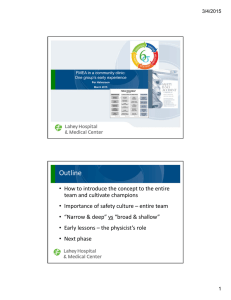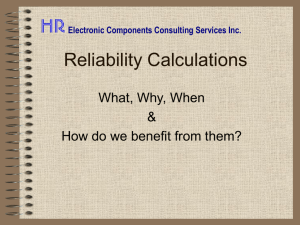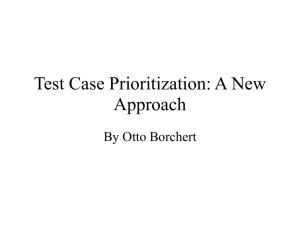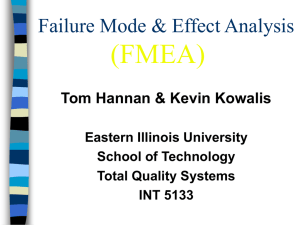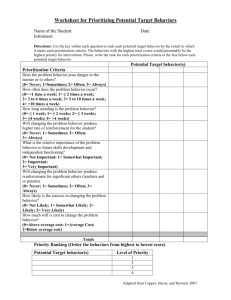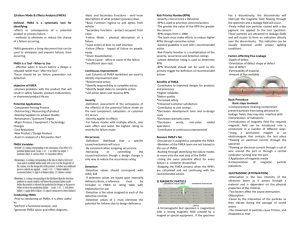Risk Management 2
advertisement
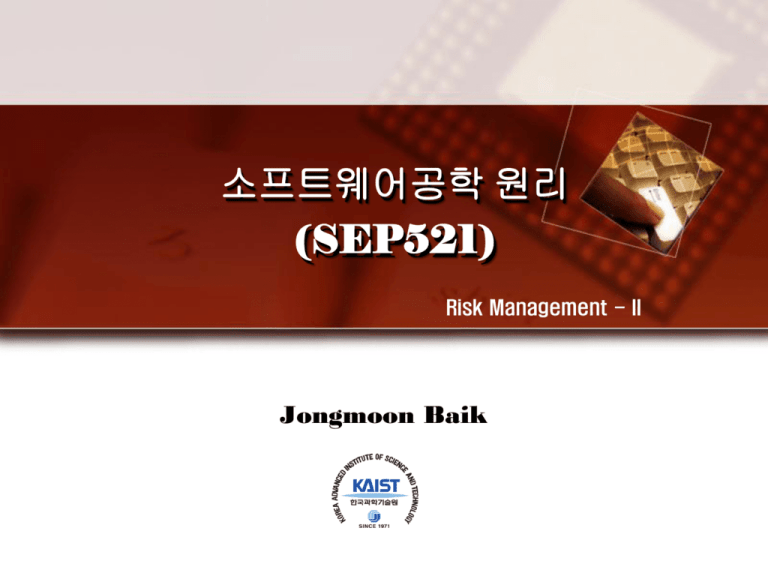
소프트웨어공학 원리 (SEP521) Risk Management - II Jongmoon Baik Taxonomy-Based Questionnaire (TBQ) • Questionnaire organized according to the taxonomy of software development for the purpose of identifying risks by interviewing a group of one or more individuals in a structured brainstorming • TBQ can be tailored or expanded to meet additional needs CMU/SEI-93-TR-006 : “Taxonomy-Based Risk Identification” 2 S/W Development Risk Taxonomy 3 Example: TBQ Questions 4 TBQ Interview & Protocol • The TBQ interview is conducted by a trained facilitator/interview team and uses the TBQ as the basis for conducting interviews • Peer groups typically include – – – – S/W engineers Technical manages Support groups (CM, QA, Testing) Project manager 5 Risk Analysis and Prioritization Analyze & Prioritize Risks 6 Risk Analysis • Assess the loss of probability and loss magnitude for each identified risk item • Assess compound risks in risk-item interactions • Typical risk analysis techniques – Performance models – Cost models – Network analysis – Statistical decision analysis – Quality factor analysis (reliability, availability, security, etc.) 7 Risk Attributes • Understand risk better by determining its probability, timeframe, and impact – Generate values for • Impact: The potential loss or the effect on the project if the risk occurs • Probability: The likelihood that the risk would occur • Timeframe: The period of time left until the risk should be addressed 8 Various Levels of Evaluation 9 Possible Definitions • Impact – Catastrophic • Schedule slip > 20%, Cost overrun > 25% – Critical • Schedule slip 10-20%, Cost overrun 10-25% – Marginal • Schedule slip 5-10%, Cost overrun 5-10% • Probability – Very likely > 70% – Likely ~50% – Not likely < 30% • Timeframe – Near term Within a month or so – Mid term Within three months or so – Long term Within six months or so 10 Risk Exposure RE = P(L) * S(L) Major Risk Risk Probability High Check Utility Loss Estimate Low Check Probability Estimate Little Risk Low Loss of Utility High 11 Risk Exposure Matrix 12 Consequences of Software Failure Risk Prioritization: NASA NPD 2820 Grave HIGH Substantial MEDIUM Marginal LOW Insignificant 256 16 Total likelihood of Software Failure 13 Risk Prioritization • Produce a ranked ordering of the identified and analyzed risk items – Figure out which risks are most important – Establish which risks should be dealt with first • Typical risk prioritization techniques – Risk exposure analysis – Risk reduction leverage analysis (Cost-Benefit analysis) – Pareto Top N risks – Delphi or Group consensus (Multivoting) techniques 14 Risk Exposure Factors (Satellite Experiment Software) Unsatisfactory Outcome (UO) A. S/ W error kills experiment B. S/ W error loses key data C. Fault tolerance features cause unacceptable performance D. Monitoring software reports unsafe condition as safe E. Monitoring software reports safe condition as unsafe F. Hardware delay causes schedule overrun G. Data reduction software errors cause extra work H. Poor user interface causes inefficient operation I. Processor memory insufficient J. DBMS software loses derived data Prob (UO) 3-5 Loss (UO) 10 Risk Exposure 30 - 50 3-5 8 24 - 40 4-8 7 28 - 56 5 9 45 5 3 15 6 4 24 8 1 8 6 5 30 1 7 7 2 2 4 15 Risk Exposure Factors and Contours Satellite Experiment Software 16 Risk Reduction Leverage (RRL) REBEFORE - RRL = REAFTER RISK REDUCTION COST · Spacecraft Example LONG DURATION TEST LOSS (UO) PROB (UO) B RE B $20M 0.2 $4M PROB (UO) A REA 0.05 $1M COST $2M RRL 4-1 2 = 1.5 FAILURE MODE TESTS $20M 0.2 $4M 0.07 $1.4M $0.26M 4- 1.4 = 10 0.26 17 Risk Prioritization: Pareto Top N Risks • • • • Calculate Risk Exposure Rank all the risks Decide on a cut-off mark Easy, Straightforward, Not resource intensive method 18 Risk Prioritization: Multivoting • Quick, Straightforward, Easy-to-use method • When to use: – When facing a group decision. – To select the most. important risks from a list. – To select from a small-. mid size list <50. One participant vote Number of votes 19 Risk Management Planning • Help you prepare to address each risk item – – Buying information, risk avoidance, risk transfer, risk reduction Includes the coordination of the individual risk-item plans with each other and with overall project plan • Typical Risk Mgmt. techniques – – – • Checklist of risk-resolution techniques Cost-benefit analysis Standard risk management plan outlines, forms, and elements For Each Risk Item, Answer the Following Questions: Why? Risk Item Importance, Relation to Project Objectives 2. What, When? Risk Resolution Deliverables, Milestones, Activity Nets 3. Who, Where? Responsibilities, Organization 4. How? Approach (Prototypes, Surveys, Models, …) 5. How Much? Resources (Budget, Schedule, Key Personnel) 1. 20 Risk Resolution (Mitigation) • Produces a situation in which the risk items are eliminated or otherwise resolved – e.g.: Risk avoidance via relaxation of requirement • Typical Risk Resolution Techniques – Prototypes, Simulation, Benchmarks, Mission Analyses, Key-personnel agreements, design-to-cost approaches, and incremental development 21 Risk Monitoring • Involves the followings: – Tracking the project’s progress toward its resolving risk items – Taking corrective action where appropriate • Typical Risk Monitoring Techniques – Milestone Tracking • Monitoring of risk Management Plan Milestones – Top-10 Risk Item Tracking • Identify Top-10 risk items • Highlight these in monthly project reviews • Focus on new entries, slow-progress items Focus review on manger-priority items – Risk Reassessment – Corrective Action 22 Project Top 10 Risk Item List • Satellite Experiment Software 23 What Risk Management is not? • Silver Bullet • A way to solve project management problems with respect to: – – – – – Budget Planning Scheduling Passive A one time deal 24 Risk Management is: • Ongoing (Continuous) • A Team sports • The key is to identify the right risks • You get better at it over time but you have to start • Start Now, start early in your project as your risks will not go away if you ignore them 25 Software FMEA • FMEA (Failure Mode & Effect Analysis) – A powerful pro-active engineering quality method (one of Six Sigma tools) – identify and counter weak points in the early conception phase of products and processes – benefits obtained encompass by large the investments in time and resources to execute the analysis • FMEA Types – – – – – System - focuses on global system functions Design - focuses on components and subsystems Process - focuses on manufacturing and assembly processes Service - focuses on service functions Software - focuses on software functions 26 Benefits of FMEA • Improve product/process reliability and quality • Increase customer satisfaction • Early identification and elimination of potential product/process failure modes • Prioritize product/process deficiencies • Capture engineering/organization knowledge • Emphasizes problem prevention • Documents risk and actions taken to reduce risk • Provide focus for improved testing and development • Minimizes late changes and associated cost • Catalyst for teamwork and idea exchange between functions 27 When to Apply S/W FMEA? • A new product or process is being initiated (at the beginning of the cycle). • Changes are made to the operating conditions the product or process is expected to function in. • A change is made to either the product or process design. The product and process are inter-related. When the product design is changed the process is impacted and vice-versa. • New regulations are instituted. • Customer feedback indicates problems in the product or process. 28 Example: Software Inspection Process http://www.sei.cmu.edu/sema/pdf/sdc/houston.pdf 29 Example: Software FMEA (Risk Assessment) 30 Example: Software FMEA (Risk Control) 31 Example: Software FMEA (Risk Profile) • 47 risks are identified • Focus on High RPN risks (20%) – Based on constraints of resources • Highest percentage of RPN: Meeting 32 Causal Relation of Top 5 Risks (RPN > 500) 33 Risk Reduction by Moderator Training • Total Risk can be reduced by 50% via effective training of moderators Moderator Role In Software Inspection Process 34 Other Risks & Recommendations • Inadequate Review, little or no rework found due to review rate – Gather data on product size, review rate, and influence on inspection results – Develop guidelines based on data – Train reviewers in use of guidelines for product sizing and review rate 35 Key Contributions of Risk Mgmt. • Create focus on critical success factors in the process • Provide techniques that let the project deal with the critical success factors • Provides some of skills, an emphasis on getting good people, and a good conceptual framework for sharpening judgments • But, Risk Mgmt. : Not a cookbook approach – Great Measure of human judgment is required to handle all the complex people oriented and technology-driven success factors in projects 36 http://www.softwaretechnews.com/technews2-2/cartoon.html 37 Q&A 38



